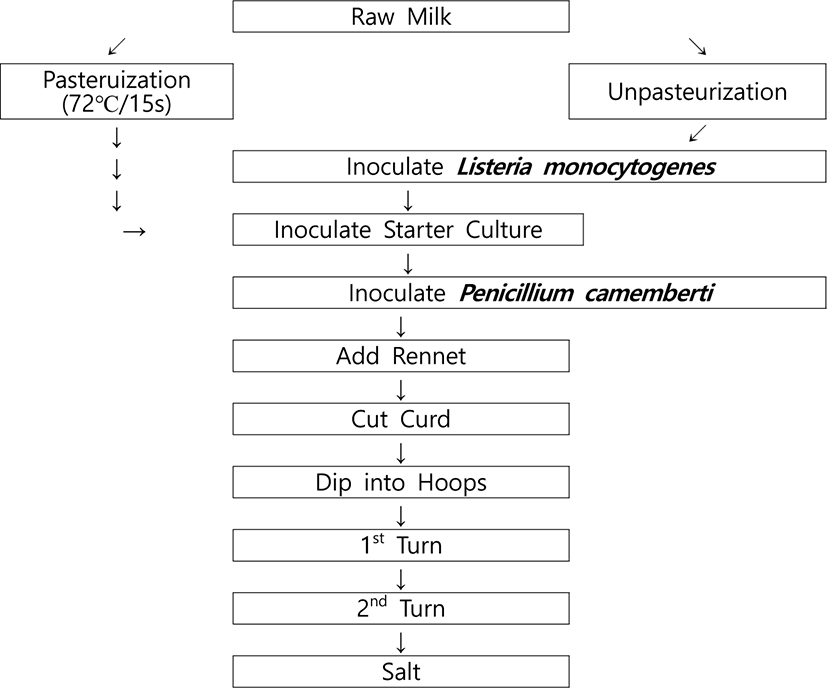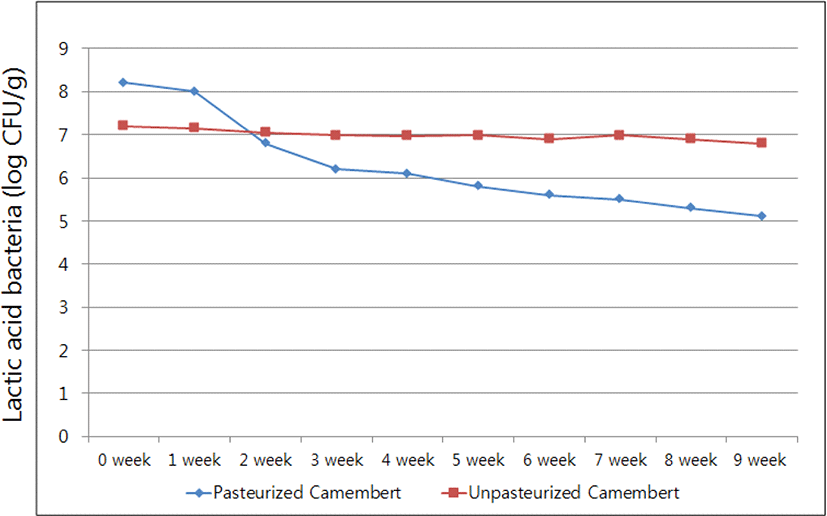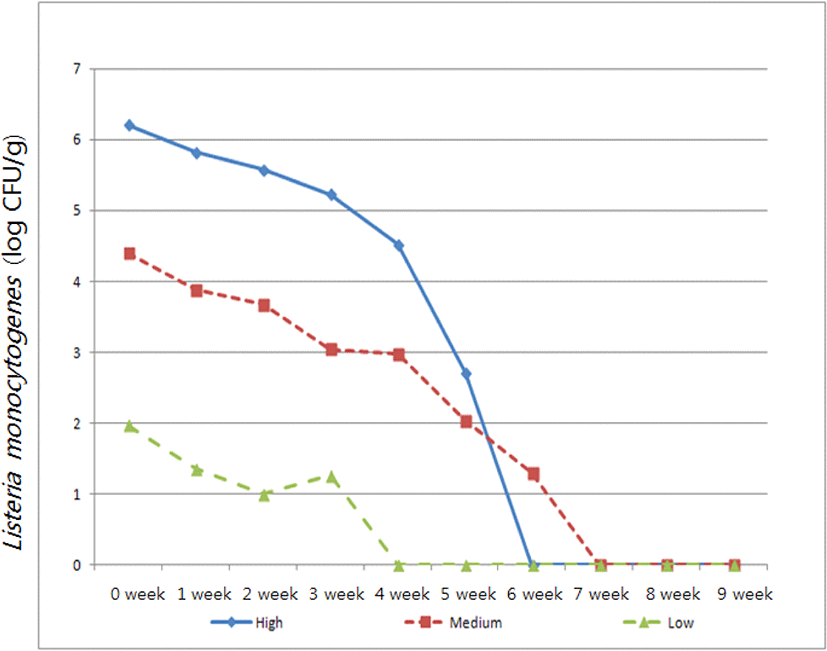Introduction
Listeria monocytogenes is a zoonotic pathogen and is widely distributed in nature, especially wild animals and poultry, sewage and wastewater [1-3]. L. monocytogenes is common in the natural world, such as soil, grass, animal feces, and water, and foods that cause food poisoning are mainly dairy products related to cheese and milk, ice cream, fish, and meat [4-6]. L. monocytogenes has recently come to public attention due to large-scale food poisoning cases in the United States [7,8]. In particular, as consumption of ready-to-eat convenience foods or semi-cooked foods increases, the risk of food poisoning caused by L. monocytogenes has increased [7,8]. In general, listeria pathogens have an incubation period of about 70 days [1,9].
Camembert is a soft, soft cheese produced in the Normandy region of France [10]. It was first made in the town of Camembert and took its name [10,11]. In particular, when Camembert cheese is fresh, it has a brittle property [10-12]. However, the older it is, the softer it becomes and the stronger the taste [11,12]. Therefore, Listeria is frequently found in some soft cheeses [13,14]. This is because soft cheeses, even pasteurized, are more acidic and moist than hard cheeses [15,16]. Therefore, these conditions are favorable conditions for Listeria to grow [15,16].
Camembert-type cheese-derived L. monocytogenes food poisoning accidents consistent with the above description are as follows. On February 11, 2013, a third death occurred among patients with listeria infections at the Jindi Cheese Company in Victoria, Australia [17]. It was found that the death was confirmed to be related to listeriosis in Jindi Cheese Company [17]. Even Victoria’s Department of Health reported that a pregnant woman living in New South Wales had miscarried [18]. According to the final report, L. monocytogenes originated in 1 kg blocks of brie and camembert cheese manufactured by the Jindi Cheese Company in Gippsland, Victoria [17,18]. And on February 25, 2014, it was reported that seven Maryland residents were hospitalized for contracting Listeria bacteria after eating Listeria-infected Hispanic-style cheese [8,19]. The U.S. Centers for Disease Control and Prevention (CDC) said the outbreak was caused by Listeria-contaminated cheese, and even resulted in one death in California [8,19]. The product is Caujada en Terron cheese, made by Ruth Foods of Kenton, Delaware, and is a soft, medium-firm Hispanic style [8,19].
According to the revised cheese manufacturing and processing standards of the Korean Food Code, cheese manufactured using unpasteurized raw milk must be aged for 60 days [20]. Cheese made from unpasteurized raw milk that meets these conditions mentioned above has been allowed to be sold in Korea since January 1, 2018 [20]. In general, milk is a food rich in nutrients, but it is also a food greatly affected by the external environment [20]. Because of these characteristics of milk, unpasteurized cheese manufactured without pasteurization of raw milk should be inspected based on more stringent management standards.
Therefore, in this study, Camembert cheese made from unpasteurized raw milk was inoculated with L. monocytogenes at various concentrations to evaluate the safety of unpasteurized Camembert cheese during the ripening storage period of more than 60 days.
Materials and Methods
The unpasteurized raw milk with high quality was purchased from Konkuk Milk and used in this study. Standard plus 900 (Chr. Hansen, Denmark) was used as the clotting enzyme, rennet. Penicillium camemberti was purchased from SAMIK Dairy & Food, and used in the manufacture of Camembert cheese. And Lactococcus lactis subsp. cremoris, Laccococcus lactis subsp. lactis, Lactococcus lasctis subsp. lactis biovar. diacetylactis, Streptococcus salivarius subsp. thermophilus, and Lactobacillus helveticus were purchased from SAMIK Dairy & Food. Each lactic acid bacteria was subcultured three times in 10% sterilized skim milk to improve vitality and then used at the time of inoculation.
L. monocytogenes isolated from food was provided by the US FDA (5100 Paint Branch Parkway, USA) and used in this study. The thawed strain was spread on Nutrient agar (Oxoid, UK) and incubated aerobically at 37°C for 24 hours. A single colony was selected from the cultured colonies and cultured in Tryptic Soy Broth (Oxoid) at 37°C for 24 hours, and the bacterial solution subcultured three or more times was diluted and used as an inoculum.
In this study, Camembert cheese produced by pasteurized raw milk was used as the control group, and Camembert cheese was manufactured with unpasteurized raw milk as the treated group. Camembert cheese made from unpasteurized raw milk was inoculated with L. monocytogenes at various concentrations, and changes during the storage period of more than 60 days were observed. After draining overnight at room temperature (about 23±2°C), Camembert cheese were dry-salted and then ripened 10 days at 15±1°C with 90±5% relative humidity so as to enable to desirable growth of Penicillium camemberti. And after 10 days, Camembert cheese were wrapped in foil and ripened at 6°C. Camembert cheese was prepared according to the method of Ryser & Marth [21] (Fig. 1).

Water activity (aW) measurement is as follows. Water activity was measured three times using a Benchtop water activity meter (Aqualab, USA), and the average value was expressed as the water activity value of Camembert cheese.
The pH measurement is as follows. For pH change, saline and Camembert cheese are added to a grinding tube in a ratio of 2:1 (saline:cheese=20 mL:10 g). And after homogenizing at 12,000 ×g for 2 minutes, it was measured with a pH meter (Model 720p, Istek, Korea). The average value was expressed as the pH value of Camembert cheese.
The enumeration of coliform is as follows. Add 225 mL of phosphate buffer diluted solution to 25 g of Camembert cheese sample and homogenize for 1 minute using a stomacher blender, Bag mixer (Interscience, USA). Take 100 μL, dilute by 10-fold dilution unit, spread on coliform dry film (3M Petrifilm, USA) and incubate at 36°C for 24–48 hours. Among the red colonies on a dry film (3M Petrifilm), colonies forming air bubbles were counted as the number of coliforms.
The enumeration of lactic acid bacteria is as follows. Add 225 mL of phosphate buffer diluent to 25 g of Camembert cheese sample. Homogenize for 1 minute using a stomacher blender, Bag mixer (Interscience). After serially diluting 100 μL by 10-fold dilution unit, spread on MRS agar (Difco, USA) and incubate at 36°C for 48 hours. White coli colonies on MRS agar were counted as lactic acid bacteria.
The enumeration of L. monocytogenes is as follows. Add 225 mL of phosphate buffer diluent to 25 g of cheese sample and homogenize for 1 minute using a stomacher blender, Bag mixer (Interscience). 100 uL was serially diluted in 10-fold increments, spread on Oxford agar (Oxoid), and incubated at 30°C for 48 hours. And, the number of L. monocytogenes was measured by counting the number of black rings around colonies on Oxford agar (Oxoid).
Results and Discussion
Changes in pH and water activity (aW) of Camembert cheese during aging storage are shown in Tables 1 and 2.
The pH of Camembert cheese made from pasteurized raw milk changed from 4.86 at 0 week to 5.93 at 8 weeks (Table 1). The pH of Camembert cheese made from unpasteurized raw milk ranged from 5.04 at 0 week to 5.47 at 8 weeks (Table 1).
The pH of Camembert cheese prepared by inoculating unpasteurized raw milk with L. monocytogenes was varied. In case of L. monocytogenes inoculated high, the value of pH was 5.24 at 0 week and 5.01 at 8 weeks (Table 1). In the case of L. monocytogenes inoculated medium, the value of pH was 5.26 at 0 week and 5.26 in the 8th week (Table 1). And in the case of L. monocytogenes inoculated low, the value of pH was 5.40 at 0 week and 5.00 in the 8th week (Table 1). In this study, the pH value of Camembert cheese during the ripening storage period was generally inconsistent. This result is thought to be because the surface of Camembert cheese is covered with white mold by white mold, and the inside appears as a typical cheese.
The results obtained in this study showed very similar tendencies to those of other studies [21,22].
The aW of Camembert cheese made from pasteurized raw milk changed from 0.9266 at 0 week to 0.8810 at 8 weeks (Table 2). The aW of Camembert cheese made from unpasteurized raw milk ranged from 0.9225 at 0 week to 0.8976 at 8 weeks (Table 2).
The aW of Camembert cheese prepared by inoculating unpasteurized raw milk with L. monocytogenes was variable. When the L. monocytogenes inoculum was high, the aW was from 0.9464 at 0 week to 0.9286 at 8 weeks (Table 2). In the case of L. monocytogenes inoculation was medium, the aW was from 0.9568 at 0 week and 0.8947 in the 8th week (Table 2). And when the L. monocytogenes inoculum was low, the aW was from 0.9387 at 0 week to 0.8817 at week 8 (Table 2). As the ripening period of Camembert cheese increased, aW (water activity) tended to decrease slightly in this study. The direct reason is thought to be the moisture loss of non-vacuum packed Camembert cheese.
Fig. 2 shows the changes in the number of lactic acid bacteria during aging and storage of Camembert cheese made from pasteurized and unpasteurized raw milk.

In the case of Camembert cheese made by sterilizing raw milk, it was observed that the number of lactic acid bacteria decreased during the aging period. However, in the case of Camembert cheese made from unpasteurized raw milk, the number of lactic acid bacteria remained constant during the ripening period without significant change (Fig. 2).
Qualitative tests for L. monocytogenes were simultaneously conducted in Camembert cheese made from unpasteurized raw milk, but all were negative during the ripening period (Data not shown). (Fig. 2).
Changes in the number of L. monocytogenes during ripening storage of Camembert cheese made from pasteurized and unpasteurized raw milk are as follows. In the case of Camembert cheese made from unpasteurized raw milk, a gradual decrease in the number of coliforms was observed during the ripening storage period. In particular, from the 5th week, it was observed that the coliform group completely disappeared and was not detected. On the other hand, in the case of Camembert cheese made from sterilized raw milk, no coliforms were detected from the beginning to the 8th week (Data not shown).
Table 3 and Fig. 3 show the changes in L. monocytogenes during the ripening period of Camembert cheese manufactured after inoculating unpasteurized raw milk with L. monocytogenes, a pathogenic bacterium, at various concentrations.

A variety of Camembert cheeses made by inoculating unpasteurized raw milk with L. monocytogenes were manufactured. When L. monocytogenes inoculum was high, 1.6×106 CFU/g was inoculated. When the L. monocytogenes inoculum was medium, 2.5×104 CFU/g was inoculated. And when L. monocytogenes inoculum was low, 9.3×10 CFU/g was inoculated (Table 3).
The results of quantitative detection are as follows. L. monocytogenes inoculum was high, it was 1.6×106 CFU/g at 0 week, <10 CFU/g at 8 week, and 0 CFU/g at 9 week (Table 3). When the L. monocytogenes inoculum was medium, it was 2.5×104 CFU/g at 0 week, <10 CFU/g at 8 week, and 0 CFU/g at 9 week (Table 3). When the L. monocytogenes inoculum was low, it was 9.3×10 CFU/g at 0 week, 1.8×10 CFU/g at 3 week, and 0 CFU/g at 4 week (Table 3).
The result of qualitative detection is as follows. In case of L. monocytogenes inoculation high, it ranged from (+) at 0 week to (–) at 9 week (Table 3). In the case of L. monocytogenes inoculation medium, it ranged from (+) at 0 week to (–) at 9 week (Table 3). And in case of L. monocytogenes inoculation low, it ranged from (+) at 0 week 0 to (–) at 4 week (Table 3).
In the case of Camembert cheese, L. monocytogenes tended to decrease rapidly. When the L. monocytogenes inoculum was high and medium, both quantitative and qualitative tests were positive for Camembert cheese up to the 8th week, but negative from the 9th week (Table 3 and Fig. 3). On the other hand, when the L. monocytogenes inoculum was low, in the case of Camembert cheese, L. monocytogenes was not found in both quantitative and qualitative tests from the 4th week (Fig. 3).
According to the report by Ramsaran et al. [23], L. monocytogenes was inoculated into pasteurized and unpasteurized raw milk at a concentration of 104 CFU/mL to produce Camembert cheese and Feta cheese, and then stored at 3°C for 65 and 75 days [23]. Microorganism survival was investigated. During storage, Camembert cheese showed an increase in L. monocytogenes as the pH increased [23]. Also, the samples obtained on the surface and inside of Camembert cheese showed many differences. Detection of L. monocytogenes has also been reported in Feta cheese [23].
Cases of food poisoning caused by cheese are very rare in Korea. However, the most problematic food poisoning bacteria in cheese is L. monocytogenes [20]. Therefore, in this study, L. monocytogenes was inoculated in three stages with high, medium, and low amounts, and changes in the number of bacteria were observed during the maturation period. In the results obtained in this study, all L. monocytogenes bacteria were killed in Camembert cheese within 8 weeks. In general, considering the infectious dose of the L. monocytogenes pathogen, food poisoning is not necessarily caused below the infectious dose. However, considering the risk of L. monocytogenes, various studies that can control the proliferation of L. monocytogenes in cheese manufacturing and aging processes are absolutely necessary.
Also, according to the Korean Food Code, L. monocytogenes is applied as a negative standard [20]. However, considering the characteristics of L. monocytogenes, studies on the detection of L. monocytogenes after extending the maturation time to more than 60 days for various cheeses as well as Camembert cheese made with unpasteurized raw milk should be continuously conducted.
